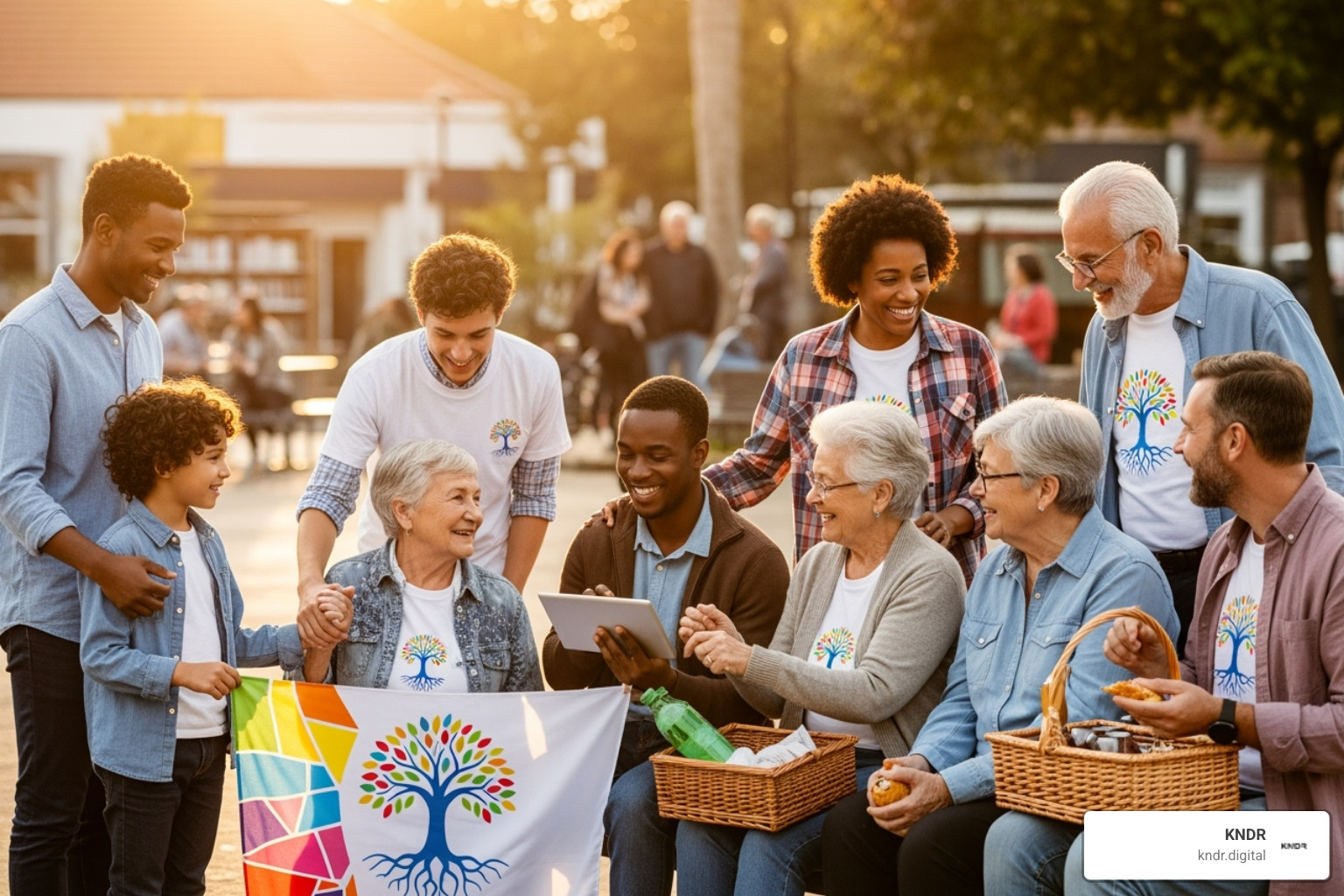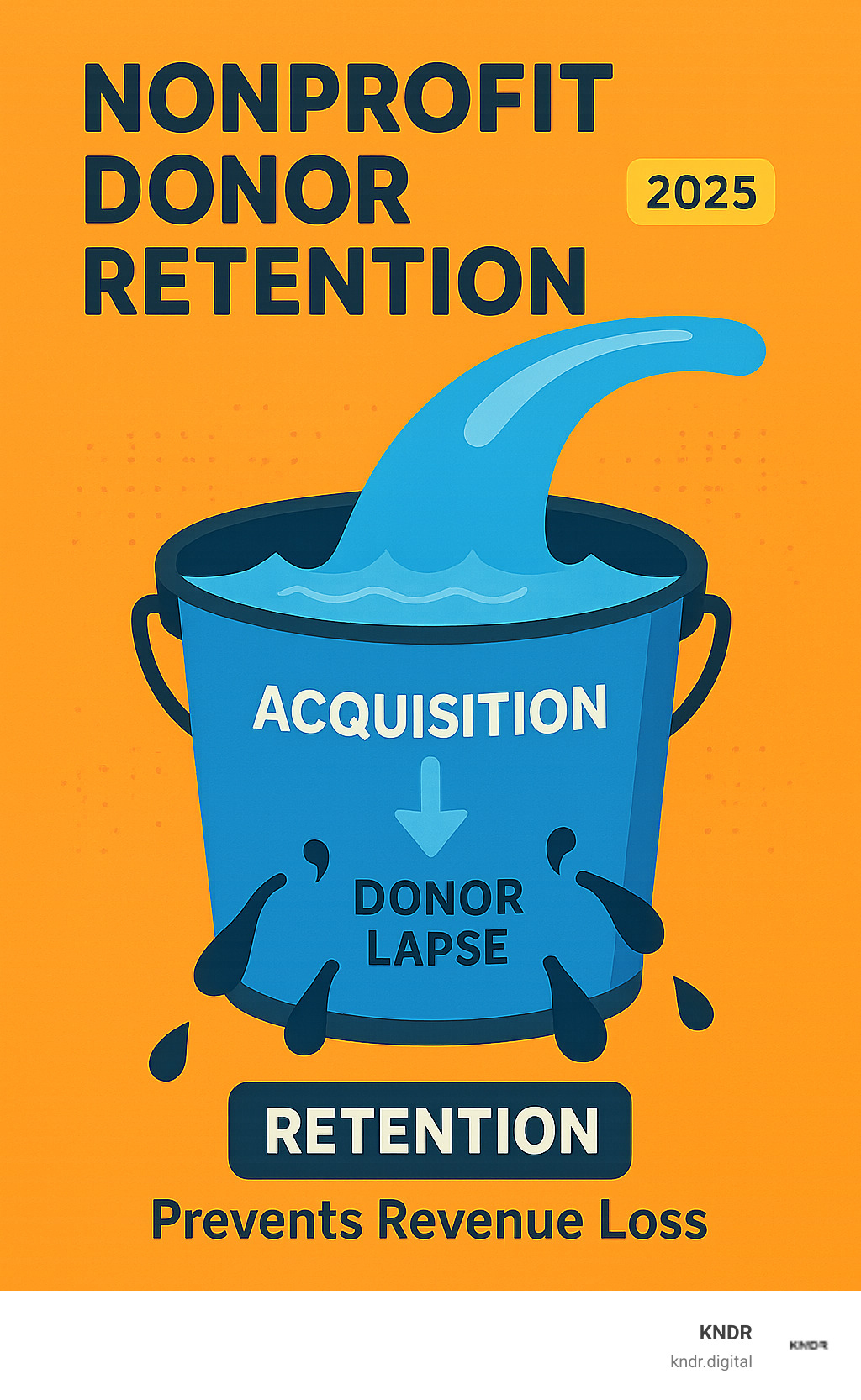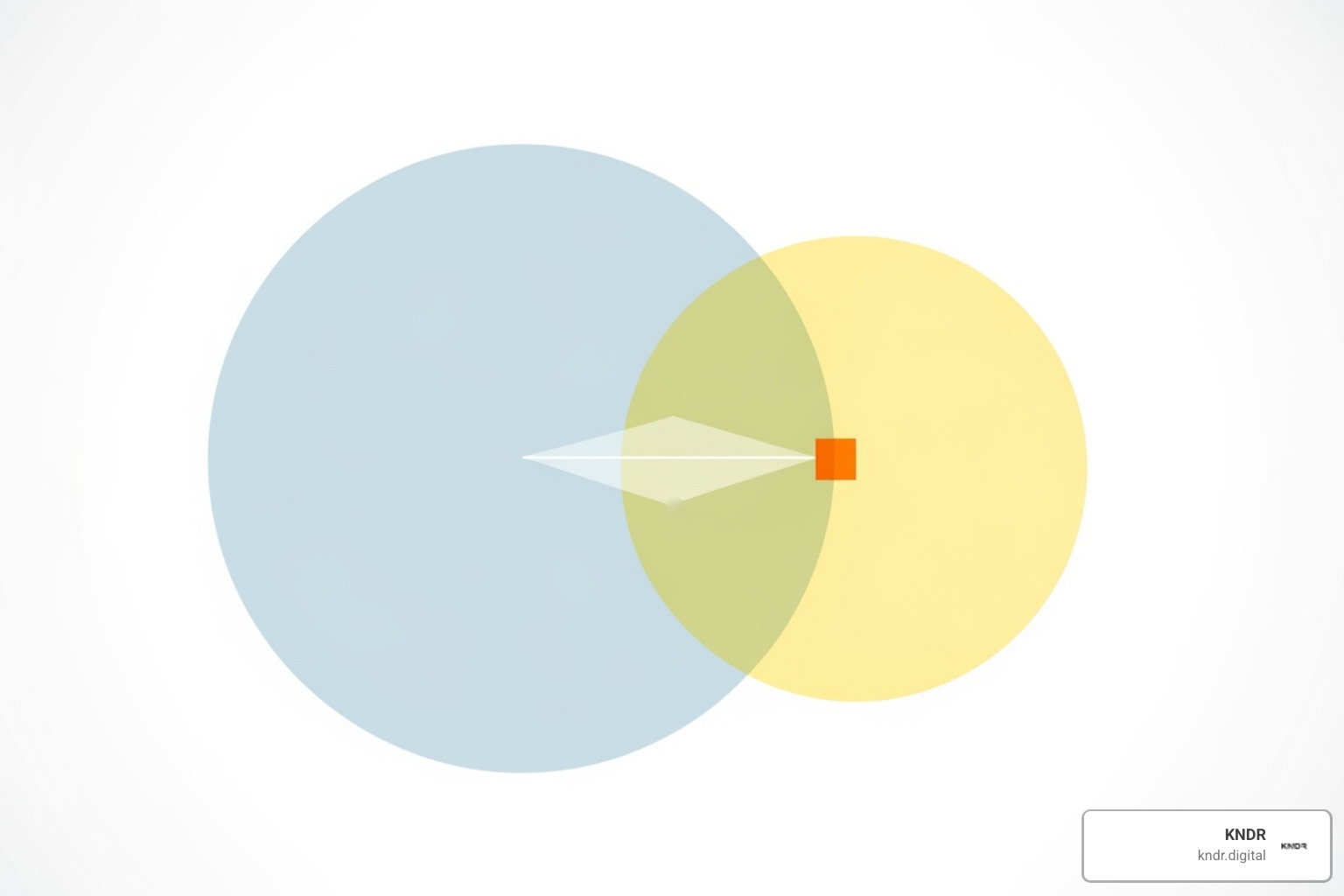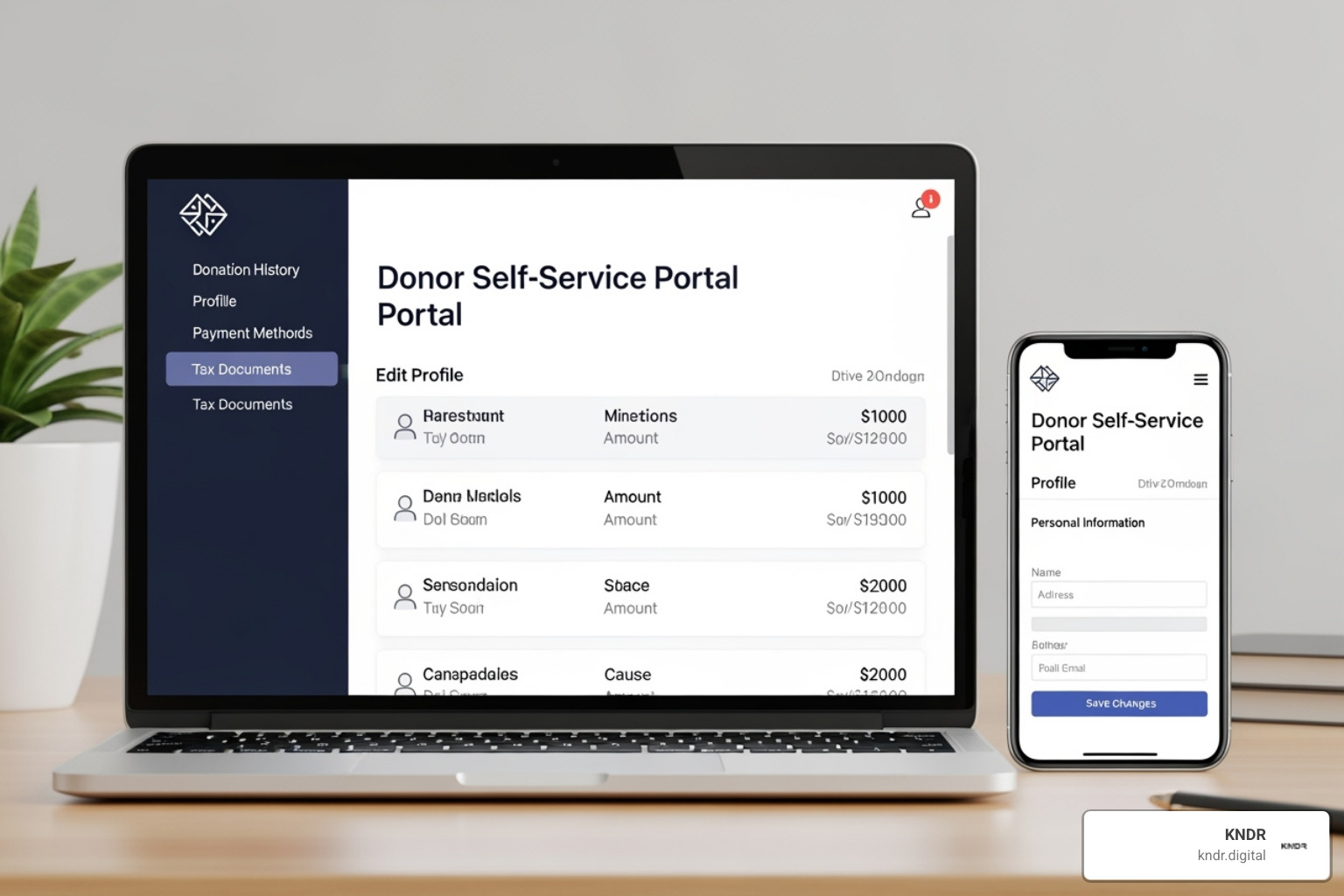Beyond the First Gift: How to Cultivate Lasting Donor Relationships

Why Nonprofit Donor Retention is More Critical Than Ever
Nonprofit donor retention is the process of keeping your existing supporters engaged and giving year after year. It's become a critical challenge as donor retention rates continue declining across the sector.
Key nonprofit donor retention strategies include:
- Thank donors within 48 hours and show genuine appreciation
- Demonstrate clear impact through stories, statistics, and beneficiary testimonials
- Offer diverse involvement opportunities beyond just monetary donations
- Create recurring giving programs to build predictable revenue
- Personalize communications based on donor preferences and history
- Use data analytics to identify at-risk donors and optimize outreach
The numbers tell a stark story. The average nonprofit donor retention rate has dropped to just 45%, with only 20% of first-time donors giving a second gift. Yet improving retention by just 10% can increase your fundraising database value by up to 200%.
Here's the reality most nonprofits face: you're losing donors faster than you can acquire them. It's like trying to fill a bucket with a massive hole in the bottom. The solution isn't just finding more donors - it's plugging the holes by building stronger relationships with supporters who already believe in your mission.
The cost difference is staggering. Acquiring a new donor costs five times more than retaining an existing one. Retained donors also give 42% more in their second year compared to their first. This means every donor you keep is exponentially more valuable than constantly chasing new supporters.
I'm Mahir Iskender, CEO of KNDR.digital, where I help mission-driven organizations scale through AI-powered marketing and digital fundraising systems focused on improving nonprofit donor retention. Over the years, I've seen how the right retention strategies can transform struggling organizations into thriving, sustainable nonprofits with loyal supporter communities.

Key nonprofit donor retention vocabulary:
Why Donor Retention is the Bedrock of Nonprofit Sustainability
Keeping existing donors isn't just helpful advice—it's critical for survival. Nonprofit donor retention transforms fundraising from a scramble for new supporters into building a thriving community of loyal advocates. Focusing on retention means investing in relationships that compound over time.
Why is nonprofit donor retention so important?
Your donors are the heartbeat of your mission. While acquiring new supporters is exciting, keeping existing ones ensures your organization has the steady rhythm it needs to thrive.
- Cost-Effectiveness: It costs five times more to find a new donor than to keep an existing one. Retaining a donor costs about $0.20 per dollar raised, while acquiring one can cost up to $1.50. Those savings go directly into your programs.
- Sustainable Funding: Loyal donors provide a predictable revenue stream, allowing you to plan ahead, expand programs, and dream bigger.
- Increased Lifetime Value: Retained donors typically give more over time. Improving retention by just 10% can increase your fundraising database value by up to 200%.
- Word-of-Mouth Promotion: Satisfied donors become your best marketers. When they feel connected, they share their experiences, and 93% of consumers choose word-of-mouth as a trusted information source.
- Powerful Advocacy: Dedicated donors can become ambassadors and advocates for your work, championing your cause by sharing on social media, inviting friends to events, or making key introductions.
The Stark Reality: Understanding Donor Lapse and Key Metrics
Unfortunately, retention rates for both new and existing donors are falling. With average retention rates below 45%, many nonprofits lose more than half their supporters each year. This donor attrition creates a "leaky bucket" where you're constantly trying to replace lost supporters. A typical charity loses 50% of first-time donors before a second gift.
Why do donors leave? The reasons are often fixable:
- Feeling unappreciated: A lack of acknowledgment makes donors feel their support isn't needed.
- Poor communication: Donors feel disconnected without regular updates on what their money accomplished.
- Lack of visible impact: Supporters can't see tangible results from their giving.
- Financial changes: Personal circumstances can change, highlighting the need for non-monetary engagement.
- Donor fatigue: Too many asks without enough stewardship can drive supporters away.
Understanding these patterns is the first step to preventing donor lapse through better relationship building.
How to Calculate Your Donor Retention Rate
Measuring your nonprofit donor retention rate shows how well you're maintaining relationships. The formula is simple, but the insights are powerful.

Donor Retention Rate = (Number of donors who gave this year AND last year ÷ Total donors who gave last year) × 100
Here, repeat donors are those who gave in both the current and previous fiscal years, while total prior-year donors includes everyone who gave last year. For example, if 350 of your 1,000 donors from last year gave again this year, your retention rate is 35%.
Benchmarks help you understand where you stand. The average repeat donor retention rate for nonprofits is around 45%, while top-performing organizations often achieve 60% or higher. You can find updated benchmarks from industry reports to use for comparison.
Track this metric regularly to spot trends and set realistic improvement goals. If your rate is below 40%, you have a significant opportunity for growth.
Core Strategies for Improving Nonprofit Donor Retention
Now that we understand why nonprofit donor retention matters, let's get practical. These core strategies are the essential tools for building lasting relationships with your supporters.
1. Master the Art of Thanking and Recognizing Donors
Feeling forgotten is the top reason donors stop giving. A heartfelt, timely thank-you isn't just good manners; it's your most powerful retention tool.

- Be Prompt and Personal: Aim to thank donors within 48 hours of a gift. Use their name, mention their specific contribution, and connect it to real impact. A follow-up handwritten note or phone call can work wonders.
- Vary Your Appreciation: Go beyond a basic note. Consider thank-you calls for larger gifts, personalized videos from staff, or custom eCards that reflect your brand.
- Offer Small Tokens: For smaller donations, branded stickers or bookmarks can be a nice touch. Mid-level donors might appreciate a t-shirt or tote bag. These tangible items keep your organization top-of-mind.
- Recognize Publicly (with Permission): For major or long-term supporters, consider recognition in annual reports or at events. Always ask donors how they prefer to be acknowledged, as some value privacy.
Effective Nonprofit Donor Engagement starts with genuine appreciation custom to each supporter.
2. Demonstrate Tangible Impact to Keep Donors Invested
Donors give to make a difference, so you must prove their contribution matters. Show them the tangible results of their generosity to keep them invested.
- Tell Compelling Stories: Share narratives of real people whose lives have changed because of your work. Our Nonprofit Storytelling Framework from Concept to Conversion can help you craft these powerful narratives.
- Use Data and Visuals: Back up stories with clear statistics (people served, animals rescued) presented in easy-to-share infographics.
- Feature Beneficiary Testimonials: The authentic voices of those you serve carry tremendous weight. Use quotes, short videos, or written stories in your communications.
- Provide Regular Updates: Keep supporters in the loop on project milestones and progress through newsletters, blog posts, and emails. Before-and-after photos are especially powerful.
3. Offer Diverse Involvement Opportunities
Not every supporter can always give financially. Offering diverse ways to get involved strengthens their connection to your mission regardless of their financial capacity.

- Volunteering: Invite supporters to contribute their time and skills at events, in the office, or on service projects.
- Advocacy: Empower supporters to champion your cause by signing petitions, contacting officials, or sharing content on social media.
- Event Attendance: Face-to-face connections at galas, workshops, or open houses let donors see your work and meet your team.
- Pro-Bono Skills: Ask supporters to donate valuable professional skills like legal, marketing, or accounting services.
- In-Kind Donations: Welcome non-cash gifts of goods or services, such as office supplies, event space, or catering.
- Peer-to-Peer Fundraising: Turn donors into active fundraisers who leverage their personal networks to expand your reach.
4. Encourage Recurring Donations and Upgrade Paths
Monthly giving programs are game-changers for nonprofit donor retention and financial stability, turning one-time gifts into reliable revenue.
- Promote Recurring Giving: Feature the monthly giving option prominently on your donation forms. Many donors prefer the convenience of automated giving.
- Recognize Monthly Donors: Create an exclusive club or program for recurring donors with unique updates or special mentions to foster a sense of belonging.
- Suggest Strategic Amounts: Research shows that presenting lower monthly amounts (e.g., $10/month) alongside higher one-time options (e.g., $100) encourages recurring gifts.
- Provide Clear Upgrade Paths: Educate donors about matching gift programs to double their impact. Cultivate loyal supporters for planned giving or major gifts through personalized stewardship.
A seamless online donation process is crucial for converting donors. Explore our Digital Fundraising Best Practices to optimize the donor journey.
Advanced Tactics: Using Data and Technology to Drive Loyalty
Once you've mastered the fundamentals, it's time to get strategic. This is where data becomes your secret weapon and technology becomes your retention powerhouse, allowing you to have meaningful, personalized conversations at scale.
How can data refine your nonprofit donor retention strategy?
Your donor database is a goldmine of insights. Every interaction tells a story about what motivates your supporters. Using this data is key to refining your retention strategy.
- Donor Segmentation: Group donors by giving patterns, interests, or engagement levels. A monthly donor of three years needs different communication than a new $25 donor. Thoughtful segmentation makes your messages feel personal.
- Identify At-Risk Donors: Data can reveal warning signs like decreased engagement or smaller gifts. This is critical because the recapture rate for lapsed donors is just 4%. Spotting these signs allows you to intervene with a personal call or survey.
- Gather Feedback: Surveys show donors you value their opinion and provide direct insights into what's working. A simple "How are we doing?" can prevent a donor from lapsing.
- A/B Test Communications: Take the guesswork out of outreach by testing different stories, email lengths, and subject lines to see what resonates most with your audience.
- Use Predictive Analytics: Use historical data to predict future behavior, like which donors might upgrade their giving or respond to a volunteer opportunity. This allows for proactive, not reactive, outreach.
For a deeper dive, our guide on Data-Driven Fundraising provides a comprehensive roadmap.
Adapting to Generational Giving Preferences
Different generations have distinct giving preferences, and understanding them is essential for nonprofit donor retention. A Silent Generation donor and a Gen Z supporter are motivated by different things.
| Generation | Born | % of Pop. | Wealth | % Donates | Avg. Gift | Avg. Charities | Motivations & Preferences |
|---|---|---|---|---|---|---|---|
| Silent Generation | 1925-1945 | 4.9% | $19.7 Trillion | 88% | $1,367 | 6.2 | Loyalty, personal connections to causes, traditional methods (mail, phone), proven impact. They tend to be very loyal to organizations they've supported for decades. |
| Boomers | 1946-1964 | 20.9% | $76.2 Trillion | 72% | $1,212 | 4.5 | Traditional, well-established organizations with proven impact. Value transparency and accountability. Prefer offline giving methods but are increasingly comfortable online. |
| Gen X | 1965-1980 | 19.5% | $37.8 Trillion | 59% | $732 | 4 | Motivated by environmental issues, education, children's welfare. Likely to fundraise, pledge, and volunteer. Prefer text messages or voice calls for quick communication; regularly check email and social media. Often pragmatic, looking for tangible results. |
| Millennials | 1981-1996 | 21.7% | $13.3 Trillion | 84% | $481 | 3.3 | Motivated by values alignment, societal and economic justice. Conduct thorough research or establish personal connections before donating. Heavily influenced by social media and peer recommendations. Prefer online giving, mobile-friendly experiences. |
| Gen Z | 1997-2012 | 20.7% | Insufficient data | 44% | $785 | 3 | Most inspired if they trust an organization, believe in its mission, and see evidence of community impact. Use social media to spread awareness and mobilize support. Value authenticity and transparency. Often give smaller, more frequent gifts; prefer mobile and peer-to-peer platforms. |
Data based on research from Statista and NPTechforGood, including Eighty-eight percent (88%) of this generation donates and other sources.
The data reveals key insights: Millennials have the highest donation rate (84%), while Gen Z's average gift is surprisingly high ($785). This means your retention strategy must be custom. A Silent Generation donor might prefer a handwritten note, while a Millennial wants to see your impact on social media. Gen X donors look for tangible results, and Gen Z values authenticity and transparency.
The key is to match your communication style and channels to what each generation values. Use data to understand your donor segments and tailor your approach. Our Donor Segmentation Strategies guide can help you implement this effectively.
Leveraging Technology for Personalized Communication and Empowerment
Technology is the great equalizer in nonprofit donor retention, allowing organizations of any size to deliver personalized experiences at scale.

- Marketing Automation: Use automation to send the right message at the right time, such as a welcome series for new donors or a thank-you on a giving anniversary.
- Personalized Email Journeys: Create different email paths based on donor interests. An education donor gets stories about students, while an environmental donor gets conservation updates. Our AI-Driven Email Campaigns can help you implement this.
- Donor Portals and Self-Service Tools: Empower donors with portals where they can update payment info, view donation history, and manage communication preferences. This improves their experience and reduces your administrative load.
- Flexible Payment Options: Remove barriers to giving by offering multiple payment methods, including credit cards, bank transfers, PayPal, and mobile wallets.
- AI for Improved Retention: Artificial intelligence is the cutting edge. AI can analyze data to predict which donors might lapse, suggest optimal communication timing, and recommend personalized ask amounts. It learns over time, constantly improving your retention efforts. For a full guide, see our playbook on Implementing AI for Donor Retention: The Complete Playbook.
The goal is not to replace human connection, but to use technology to enable more meaningful connections at scale.
Frequently Asked Questions about Donor Retention
When I work with nonprofit leaders, certain questions about nonprofit donor retention come up again and again. These are the conversations that happen behind closed doors, the concerns that keep fundraisers up at night. Let me share the most common questions I hear, along with what the data really tells us.
What is a good donor retention rate for a nonprofit?
This is the question every nonprofit professional asks, usually followed by "Are we failing?" The truth is, retention rates vary widely, and what's "good" depends on your organization's context and goals.
Here's what the numbers actually look like: The average donor retention rate across the nonprofit sector sits around 35% to 45%. If you're in this range, you're performing at industry standard - not great, not terrible, just average. But average isn't where we want to stay.
Top-performing organizations consistently achieve 60% or higher retention rates. These are the nonprofits that have cracked the code on building lasting relationships. This should be our North Star - the benchmark we're all working toward.
The first-time versus repeat donor rates tell an even more interesting story. Only 20% of donors give again after their first gift. That's a sobering statistic that highlights why that initial stewardship period is so critical. But here's the encouraging part: once a donor gives a second gift, 60% of them continue giving. This dramatic shift is why fundraising professionals call securing that second donation "the golden rule of donating."
Benchmarking against yourself matters more than comparing to others. Track your own trends over time. Even improving by a few percentage points each year compounds into substantial long-term gains for your mission.
What is the single most important factor for retaining donors?
If I had to distill years of experience and countless data points into one concept, it would be relationship building. There's no single magic bullet, but a genuine, donor-centric approach that prioritizes authentic relationships wins every time.
This means making donors feel valued as real partners in your mission, not walking ATMs. It's about consistent, meaningful communication that isn't always asking for money. It's demonstrating clear impact so donors see their generosity creating real change.
The organizations with the highest nonprofit donor retention rates treat donors like invested partners rather than mere transactions. They understand that people don't just give to causes - they give to causes they feel connected to, appreciated by, and confident in.
How soon should you ask a new donor for a second gift?
This is the delicate dance between stewardship and solicitation. Getting that second gift is crucial, but timing is everything. Move too fast, and you risk seeming pushy. Wait too long, and the donor's initial enthusiasm might fade.
Focus on stewardship first, not solicitation. Your primary job immediately after someone's first gift is to make them feel appreciated, show them impact, and build that relationship foundation.
The sweet spot is typically 3 to 6 months after their initial contribution. This gives you enough time to send proper thank-yous, share meaningful impact updates, and engage them with non-ask communications like newsletters or volunteer opportunities.
But this isn't a rigid rule. Test different timelines with your donor segments. Some donors, especially those who gave smaller initial gifts and show high engagement, might be ready sooner. Others need more cultivation time. The key is ensuring they feel genuinely connected and valued before you make that second ask.
The goal isn't just getting a second donation - it's turning that first-time giver into a lifelong supporter who feels like family.
Conclusion: Build a Community, Not Just a Database
The journey through nonprofit donor retention reveals a fundamental truth: the organizations that thrive aren't just collecting donations—they're building communities of passionate supporters who believe deeply in the mission.
Think about it this way. Every donor who receives a heartfelt thank-you within 48 hours, who sees exactly how their $50 helped provide clean water to a family, or who gets invited to volunteer at your next community event isn't just giving money. They're becoming part of something bigger than themselves.
The strategies we've covered aren't just fundraising tactics. Demonstrating tangible impact through compelling stories shows donors they're making a real difference. Offering diverse involvement opportunities beyond monetary gifts creates multiple touchpoints for engagement. Leveraging data and technology helps us personalize every interaction, making each supporter feel valued as an individual rather than just another name in our database.
The numbers tell the story clearly. When we improve retention by just 10%, we can increase our fundraising database value by up to 200%. But the real magic happens when retained donors become advocates, sharing our mission with friends and family. 93% of people trust word-of-mouth recommendations—and passionate donors are our best ambassadors.
The future of fundraising is relational, not transactional. Organizations that accept this shift will find themselves with more than just sustainable funding. They'll have a community of supporters who stick with them through challenges, celebrate victories together, and actively champion the cause in their own networks.
This change requires the right tools and strategies. Advanced automation, AI-driven personalization, and data analytics aren't luxuries anymore—they're necessities for building the kind of donor relationships that last for years, not just seasons.
The choice is clear: we can continue chasing new donors to fill our leaky bucket, or we can focus on building genuine relationships that turn supporters into lifelong partners in our mission. The organizations that choose community over database will be the ones that create lasting change in the world.
To implement advanced, AI-driven strategies that build lasting relationships and guarantee results, explore how KNDR can transform your approach.


